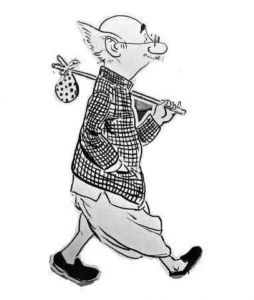 The new Albanese Labor Government in Australia in pursuing its political ideology on climate change rather accept that Australia is now totally dependent on China for a range of goods, which are critical to the economic security and defence of Australia. Should supply discontinue for any reason, Australia would be quickly and severely damaged.
The new Albanese Labor Government in Australia in pursuing its political ideology on climate change rather accept that Australia is now totally dependent on China for a range of goods, which are critical to the economic security and defence of Australia. Should supply discontinue for any reason, Australia would be quickly and severely damaged.
Prime Minister Albanese must make up his mind whether he wants to let Minister Bowen continue to pursue his governments uncosted ideological objective to achieve a 43% reduction in emissions by 2030, or whether his government should tackle a grave situation which challenges Australia’s sovereign nation status.
The Five Eyes nations, Australia, New Zealand, Britain, America and Canada, who cooperate in the collection of military intelligence, have been told by former MI6 Chief Sir Richard Dearlove’s Henry Jackson Society, that it is now evident that China’s goal over the last decade or so has been to make national economies dependent on China in critical economic and defence sectors. The Five Eyes nations have been told that China has achieved its goal. Dependence on China must be broken, the Five Eyes must now cooperate to prevent China expanding unopposed its authoritarian vision for the world. In other words, the time has come for coordinated economic warfare against China.
A study by a UK think tank, the Henry Jackson Society, last year examined the dependency of the Five Eyes countries—the US, the UK, Canada, Australia and New Zealand—on China and found that Australia was by far the most exposed.
‘The study applied three tests to establish whether a country was strategically dependent on China: the country had to be a net importer of the goods in question, more than half its imports of the goods had to come from China, and China’s global market share of those goods had to be greater than 30%. The tests meant that in the event that supplies from China were interrupted, it would be difficult for the importing nation to replace them.
It found that of the 5,914 categories of goods imported by the five nations, Australia was strategically dependent on China for 595, which was more than any other country.’
China’s plan for Australia was revealed by the Henry Jackson Society report. China executed its plan whilst Australians were basking in a robust economy, where the Gross National Income (GNI) tripled between 1990 and 2018 which demonstrates that Australians were buying, without blinking, ever increasing amounts of products made in China and so less made in Australia.
China has been quietly achieving its objective to make the economies of some of the worlds leading nations dependent on them with little or no concern expressed at any government level in Australia that China was becoming so dominant in the home markets.
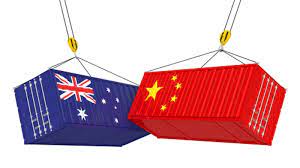 Australia’s dependency on China was particularly exposed during the Covid19 pandemic. Personal Protective Equipment (PPE) became unavailable, this included but not only clothing, face shields, gloves and masks. It was found that China made most of the ventilators in the world and suddenly all the world wanted them. It caused grave concern when it was found that China provided most of the Australia’s penicillin, other antibiotics and many other medicines important to life, including morphine and compounds for pain control. As those shortages became apparent, questions were asked, few answers were given. There can be no doubt that shortages of PPE contributed to the spread of Covid19 and probably to the death toll. Australian industry and governments had been caught asleep at the wheel.
Australia’s dependency on China was particularly exposed during the Covid19 pandemic. Personal Protective Equipment (PPE) became unavailable, this included but not only clothing, face shields, gloves and masks. It was found that China made most of the ventilators in the world and suddenly all the world wanted them. It caused grave concern when it was found that China provided most of the Australia’s penicillin, other antibiotics and many other medicines important to life, including morphine and compounds for pain control. As those shortages became apparent, questions were asked, few answers were given. There can be no doubt that shortages of PPE contributed to the spread of Covid19 and probably to the death toll. Australian industry and governments had been caught asleep at the wheel.
These are some of the products on which Australia is dependent on China to supply. They are all considered to be of strategic importance to the functioning of the defence and the economy of Australia, simply and of great concern, because an alternative supply is not readily available from another source.
China’s share of the total Australian market:
83% of semi conductors, diodes and transistors. 68% of all computers. 62.5% of radio and TV transmitters, television cameras. 75% of Lamps and lighting fittings, illuminated signs, etc. 57% of insulated wire and cable, optical fibre cable. 57.5% Structures, parts of structures of iron or steel. 43% of Electric transformers, static converters and rectifiers. 71% of electric generating sets and rotary converters. 78.4% of all aluminium structures, parts, for construction.
Broad product categories conceal points of extreme dependence. China supplies 40% of Australia’s imports of nuts and bolts, but that share will be closer to 100% for some specifications. The same is true of Chinese supplies of essentially humble but indispensable products like hinges, padlocks and gaskets.
A list compiled by David Uren adds to and explains the conclusions arrived at by the Henry Jackson Society. The list is long, very long. Who would have thought that China supplies 70% of almost everything women and girls wear and supplies the the same percentage of the market for woolen and knitted items,together valued at $1.2 billion a year (FIS)? Fifty per cent of household heating appliances come from China. Sixty five per cent of the furniture market worth $1.2 billion also comes from China.
There was some publicity on the release of Henry Jackson Society report and findings, but like all news it soon disappeared and so the Australian people remained in the dark regarding what is after all, a very serious situation.
Whether the lack of publicity was because the government at the time deliberately avoided telling the people of Australia’s dependence on China and subsequently its vulnerability, we shall never know.
I found writing my last article in the Global Farmer disconcerting. It dealt, if you remember, with Australia’s ever increasing imports from China, but apart from the raw import values I couldn’t determine just how important how dependent Australia is on the Middle Kingdom — now I do know — the report from the Henry Jackson Society concerns me greatly — it should concern everyone in Australia, particularly our leaders.
Attached to the Henry Jackson Society Report on the five eyes are essays written by political representatives from each of the countries involved. Andrew Hastie MP provided an essay from Australia. It was a bit lame I thought, didn’t say much of consequences of dependency except Australia should take steps to rectify the situation.
How Did China Seduce Australia?
Australia like most of the world has spent the last twenty to thirty years basking in the glow of world peace and prosperity.
They have been halcyon years. World demand, mainly from China for minerals and fossil fuels increased exponentially and Australia happily met those demands. Capital flowed into the country to develop mining assets and purchase infrastructure and vast fortunes were made.
Tourism, mainly from China, boomed as did what is known as the services industries. Agriculture changed, sheep numbers went down and the cropped area increased, grain prices remained stable, tonnages increased. Migration numbers drove urban development on a grand scale so houses had to be built, as well as hospitals, schools and the like.
The Gross National Income (GNI) tripled between 1990 and 2018, the annual growth between 2020 and 2021 was 5.4% putting the GNI per capita at US$56,760, no doubt buoyed by record breaking prices for fossil fuels and iron ore, which went to China.
Unlike the challenges faced by previous generations, particularly the ‘Silent Generation’ (born between 1925 and 1945) and apart from the recent and badly managed pandemic at both state and federal level, there has been little to nothing in the last 30 years or more to test the metal, the grit and determination of the Australian people, whether they be ‘Baby Boomers’ , ‘Generation X’ or the Millennials, they have all had an easy ride through life — so far.
That has now all changed. Australia must be made to realise, there is now a huge price to pay for the years in Camelot. Australia’s dependence on goods imported from China and the demise of its own manufacturing base has placed the nations security and national sovereignty in peril. Australia must accept this fact and quickly take steps to fix it. As tensions around the region increase and China becomes more bellicose, there is an urgency to act, an urgency which challenges Australia’s laissez-faire view of the world. ‘She will not be all right —mate.
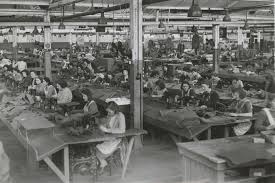
In the 1960s manufacturing employed 25% of the available labor and was 25% of the Gross Domestic Product (GDP). Today it is a sad tale. Manufacturing is still important to the economy in Australia but it only represents 5% of GDP and 5.4% of all employment. This is a poor record compared to the rest of the world:
Manufacturing makes up about 16% of the workforce in Germany, Japan, and Switzerland. Canada – an economy otherwise similar to ours – has 1.7m manufacturing workers, against our 47,500. In Israel and Sweden, with far smaller populations, advanced manufacturing is thriving.
South Korea – the world’s fifth-largest export economy and the sixth-most complex economy according to the Economic Complexity Index (ECI) – had a positive trade balance of $124bn in 2017. In comparison, Australia lags behind as the 20th-largest export economy in the world and, embarrassingly, the 59th-most complex economy. In 2017, Australia had a positive trade balance of just $44bn – a mere third of that of South Korea.
It is a matter of South Korean national pride to buy South Korean-made goods, from trains to cars to telephones. Imports and sales of products such as German-made cars and iPhones are some of the lowest in the world in South Korea.
Why? Because every element of government and the South Korean people work together to support their local manufacturing industry. There is a real cultural and governmental focus on growing and protecting their local economy and developing their own strengths.
Australian manufacturing has declined due to the inexorable march of industrialised China, helped in no small way by large Australian corporations like BHP who, one time, awarded a 20,000 tonne structural steel work to an offshore manufacturer, and they were not Robinson Crusoe in that regard, the State governments in Queensland, Victoria and NSW have all had new trains fabricated overseas, some in China.
 The Asian Century – We Wanted China as Much as they Wanted Us.
The Asian Century – We Wanted China as Much as they Wanted Us.
China’s progress has been inexorable. In what seemed just a few years but it was about twenty, China moved from being a copier of western technology and the source of cheap and trashy goods, to being a nation which persuaded big and small industry and technology companies from the West to move their manufacturing, their jobs and in many cases their research, to China.
Chinese products in the market added to the complacency in the Australian economy and society. Year on year imports from China increased together with the quality of what they made. Eventually no one could deny that many of the goods made in China were cheaper and of equal quality to those same products made in Australia. Retail chains reliant on Chinese product started to dominate the high street. Bunnings, Harvey Norman, K Mart, Target and Office Works to name a few, all heavily reliant on goods from China.
That was how China seduced Australian manufacturers, the chance to produce a cheaper product of the same quality, in China. A product which, would have a higher margin than when made in Australia. More profit meant happy Boards, which meant happy shareholders and big performance bonuses for management. The Chinese seduction, worked!
The Abbott Government – Team Australia.
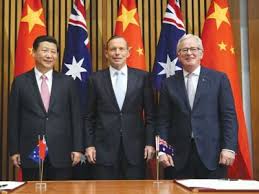
Slowly year by year Australia’s dependency on China increased. A Free Trade Agreement under the Abbott government gave China almost free and unfettered access to the entire Australian market. It was a different world then, or so it seemed through Australian eyes.
The same Australian government encouraged the creation of Australian sister towns with towns in China, as a demonstration of Australia’s friendship. The State of Victoria and Premier Dan Andrews went a step further and agreed, illegally as it turned out, to be part of China’s global ‘belt and road initiative’.
Elected in 2013 nearly a decade ago, there were no bigger friends to China than Tony Abbott and his government. So enthusiastic was Abbott about Australia’s future with China, that in 2014 he took a delegation of 600 people to China. Leaders from Australian politics, business and the bureaucracy, made up what Abbott called ‘Team Australia’ and ‘one of the most important delegations ever to leave Australia’. In China, Abbott articulated Australia’s wish to ‘be a true friend’ and ‘help build the Asian Century’.
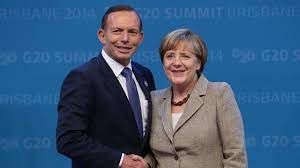
In April 2015, the Australian media revealed that in November 2014 Abbott had privately told German leader Angela Merkel that Australia’s policy towards China is driven by ‘fear and greed’ — sentiments that tally well with the unofficial strategy of ‘engage and hedge’.
Chinese investment is now part of life in the Australian economy, it can be seen everywhere. It adds another dimension to China being the supplier of products critical to the economy and security of Australia.
The Chinese have invested strategically, they are involved in what makes this country tick. They have a 99 year lease on the Port of Darwin. They own the Port of Newcastle and have a 20% share in the Port of Melbourne. In the eastern States and in South Australia Chinese companies with deep ties to the CCP own vast swathes of the national power infrastructure, both gas and electricity, both generation and delivery. They own Western Australia’s only gas pipeline from Dampier to Bunbury. They own the mine that provides Western Power with coal. They are major rural landowners (3rd biggest after America and UK) and have many investments in city real estate. Most Chinese ‘investment’ in Australia whether it is based in China or Hong Kong, can be traced back to the CCP.
So What can Australia do?
The new Federal Government and Prime Minister Albanese have promised to restore Australia’s manufacturing base, but at the moment it is all talk —their main agenda appears to be on Minister Bowen, literally, tilting at wind turbines (and solar panels) like a latter day Don Juan, in Bowen’s case not obsessed with the fair sex, but with the ideology of climate change and achieving emissions reduction of 43% below 2005 levels by 2030. That is a big task and it won’t be achieved without the wholehearted support of the population at large and massive public and private investment, probably running into billions, in the renewable energy transmission and generation sector.
There are two big challenges for the Albanese government, it cannot be one or the other. The first is to meet the ideological challenge they have set themselves on emissions reductions. The second is how they ensure national sovereignty and security by finding ways to employ perhaps 15% to 25% of the available labour to start manufacturing those products which will get Australia out of the grip of being dependent on the Chinese Communist Party (CCP).
There is a third challenge as old as Australia itself. Australia is an island. Islands are vulnerable and one the size of Australia, extremely vulnerable and hard to defend.
 In recent years we have seen what China is capable of. They have unilaterally punished Australia whenever they have wished to. Those punishments for a time hurt Australia, particularly its farmers. China demonstrated an arrogance towards Australia which showed past demonstrations of friendship meant nothing to them. They showed to Australia and to the world that agreements, FTAs, contracts and the like are valueless — they now see themselves as omnipotent. They laugh at Australia and are prepared to humiliate its leaders in the most public way. I have written on these pages about the paradox of their ‘Wolf Warriors’.
In recent years we have seen what China is capable of. They have unilaterally punished Australia whenever they have wished to. Those punishments for a time hurt Australia, particularly its farmers. China demonstrated an arrogance towards Australia which showed past demonstrations of friendship meant nothing to them. They showed to Australia and to the world that agreements, FTAs, contracts and the like are valueless — they now see themselves as omnipotent. They laugh at Australia and are prepared to humiliate its leaders in the most public way. I have written on these pages about the paradox of their ‘Wolf Warriors’.
China is quite capable of ‘interfering’ with Australia’s main shipping lanes to teach us another ‘lesson’ and in so doing, stranding this island from the rest of the world.
The Island of Australia.
The Australian coastline extends for some 34,000 kilometres and includes over 1000 estuaries. The lifelines to Australia which almost all ships carrying goods into and out of Australia are the Pacific Ocean and the South China Sea.
Over 90% of Australia’s oil products have to traverse the South China Sea twice. Crude oil to Japan, Korea and surprisingly China and then back again as refined products. Oil that is refined in those countries and in Singapore is offloaded mainly on the eastern seaboard. Australia currently has less than sixty days supply of fuel in the country, probably far less.
Australia does not have and is unlikely to have for many years to come, a Defence Force capable of defending the Australian eastern seaboard with conventional forces. Western Australia may be suitable for a land invasion but there would be no point because the Nullabour remains.
Militarily, it would not be difficult for a nation with a modern navy, particularly nuclear submarines, to blockade the shipping routes to northern and eastern Australia and for that matter, to Western Australia.
It is a fallacy that Australia can feed itself. About 15% to 20% of the food consumed in Australia is imported, it is predominantly but not entirely processed food. Some of it luxury items, but the majority is food, which is now part of the everyday diet in Australia. Make no mistake, in the event of a blockade of Australia there would be a shortage of food.
 Until the 1970s Australia was a major producer of processed food, particularly fruit and dairy products. For those who can remember back that far it is difficult to recall imported food in Australia except for some household names from the UK, all to satisfy the dominant migrant population at that time.
Until the 1970s Australia was a major producer of processed food, particularly fruit and dairy products. For those who can remember back that far it is difficult to recall imported food in Australia except for some household names from the UK, all to satisfy the dominant migrant population at that time.
There is a sober lesson in all of this for Australia, this has all happened before with disastrous consequences, Albanese must, at all costs, avoid history repeating itself.
The Atlantic Ocean 1939 to 1945. The Battle for the Atlantic.
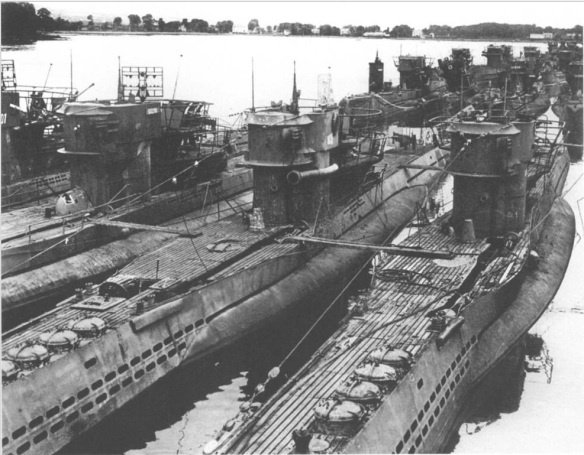
Shortly after the outbreak of WW2 in 1939 the Germans blockaded the North Atlantic Ocean in an attempt to bring Britain to its knees. Britain, then as now, produced hardly any of the oil it needed and was heavily reliant on food from other countries to feed its 47 million people. That food was mainly supplied by America, Canada, Australia and New Zealand. Britain also needed vast amounts of oil and other materials to feed it’s world dominant industrial base as it geared up for war and to defend itself against invasion.
The only ports of entry to Britain were those on the west coast (the south and the routes to the east were already blockaded by Germany) and the only ports capable of handling large quantities of ships on the west coast were Liverpool on the River Mersey and Glasgow on the Clyde. Had Germany successfully blockaded the Atlantic sea routes, Britain would have been forced to surrender or starve.
The Battle for the Atlantic was the longest battle in WW2, it started in 1939 and ended six years later in 1945. The cost to both the allied countries and the Germans was horrendous:
Victory was achieved at a huge cost: between 1939 and 1945, 3,500 Allied merchant ships (totaling 14.5 million gross tons) and 175 Allied warships were sunk and some 72,200 Allied naval and merchant seamen lost their lives.[5] The Germans lost 783 U-boats and approximately 30,000 sailors killed, three-quarters of Germany’s 40,000-man U-boat fleet. Losses to Germany’s surface fleet were also significant, with 4 battleships, 9 cruisers, 7 raiders, and 27 destroyers sunk.
Australia is in almost the same position as Britain found itself in 1939. We no longer have an industry that could quickly gear up to make warships and the 48 that we have, (China has 400) would be stretched over 36,000 km of coastline or spread out over the Pacific Ocean and the South China Sea. Our submarine fleet finds it difficult to remain afloat and is scheduled for a refit lasting decades and our nuclear deterrents are for our great grandchildren to sort out.
There is no way on earth that Australia and its allies in QUAD (The Quadrilateral Security Dialogue (QSD), colloquially know as the Quad which is a strategic security dialogue between Australia, India, Japan, and the United States) could keep Australia’s main shipping lines open all the time. The consequence of a blockade on Australian shipping lanes is obvious. Like the Atlantic Ocean for Britain, the Pacific Ocean is the gateway to Australia and the South China Sea the highway.
Australia imports of 90% of the fuels it uses and with less that sixty days supply in the country for trucks, cars, planes, agriculture and the ADF, Australia will quickly find itself in precarious position should shipping routes be closed for even a short period.
 Australia would soon grind to a halt when supplies of those goods mentioned in the Henry Jackson Society and ASPI reports stopped arriving in the country. Without semi conductors the electronics industry is finished, same goes for computers and all the spare parts needed for those already in use. Without lighting components and cable and wiring the building industry would stop as would many other industries starved of components like transformers and rectifiers the solar battery industry would die. Nuts and bolts, who would have thought we would have given away that vital industry. I am reminded of the parable of the missing horse-shoe nail that resulted in a battle being lost.
Australia would soon grind to a halt when supplies of those goods mentioned in the Henry Jackson Society and ASPI reports stopped arriving in the country. Without semi conductors the electronics industry is finished, same goes for computers and all the spare parts needed for those already in use. Without lighting components and cable and wiring the building industry would stop as would many other industries starved of components like transformers and rectifiers the solar battery industry would die. Nuts and bolts, who would have thought we would have given away that vital industry. I am reminded of the parable of the missing horse-shoe nail that resulted in a battle being lost.
The Prime Minister’s Challenge – Australia’s Future.

Since the Albanese government came to power there has been a lot of talk from and a lot of travel by Anthony Albanese, a man who is obviously intent on convincing Australians and the rest of the world, if they are interested, that he is not the self-confessed far left Tory hater of yesteryear —he has changed he claims. A claim which he has yet to prove. Actions speak louder than words and he has a little under 4 years to convince the nation.
Like his predecessor Albanese has talked time and time again about getting manufacturing back into the Australian economy.
To achieve his goal of getting manufacturing back into Australia, Albanese and his Labor government will have to convince not Australia, but the investment world, that Australia is a good place for them to put their money.
Superannuation Funds in Australia have something like $3.3 trillion dollars, so he doesn’t have to go very far to make a start. What a great investment for Australia it would be if the superannuation funds owned by Australians from all walks of life, invested in their future and that of their families.
It will be a challenge for the superannuation fund managers to determine the risk and the return of investing in an Australian manufacturing industry, rather than an airport or a shopping centre.
The Henry Jackson Society has compiled a list of what Australia should be making for itself, or at the very least lowering its dependence on China for. They are all products vital to running Australia should supplies from China be interrupted.
If Australia wishes to establish sovereign independence, and what county doesn’t want to do that, the new manufacturing industries will have to be assured, by the Federal Government, that there will be a market for the goods they make.
No matter how great Australia’s need, it has to overcome the reason(s) why manufacturers left the country in the first place. It is simplistic just to say the seduction by China, because there are countries, which have resisted China’s influence apart fro South Korea where there is an historical antipathy towards China.
Surprise, Surprise! The Previous Government  had plans to solve the Challenges Australia now Faces-But they forgot to tell Anyone!
had plans to solve the Challenges Australia now Faces-But they forgot to tell Anyone!
In October 2020, the then Australian Coalition Government announced a $1.5 billion investment in the Modern Manufacturing Strategy. From this investment, the government allocated $107.2 million to address vulnerabilities across supply chains for critical products, supporting the fourth pillar of the Modern Manufacturing Strategy.
The pillars were:
- getting the economic conditions right for business
- making science and technology work for industry
- focusing on areas of advantage
- building national resilience for a strong economy.
They got that right.
Reading on through Tranche 1 and Tranche 2 of the Coalitions plans, it is apparent that the Morrison government had read and taken notice of the Henry Jackson Society report. In their plan they go into far more detail than I have here. They have identified a list of strategic goods and medicines that Australia reliant on China to supply and which should be made in Australia.
The $1.5 billion was set aside for the express purpose of fostering industry with grant, not loan funds to enable Australia to be strategically secure. Why on earth they didn’t make this common knowledge among the Australian people before the General Election, only Scott Morrison knows.
I do not understand why the Henry Jackson Society report was not made widely known among the Australian public and I cannot understand why the previous government did not make a big thing, an electoral issue, out of their initiative to start to restore Australian manufacturing.
The Coalition were portrayed by Labor as being incompetent, and it looks like they were. Had they promoted and taken to the Australian people and Australian industry their impressive plans for the future, using their Sovereign Manufacturing Capability initiative, and Building Supply Chain Resilience, had they used up some of their advertising money in their election campaign to communicate and promote their plans for reviving manufacturing in Australia; to get away from the grip of China, then maybe, maybe there would have been a different result to the election?
To this day the coalition have a plan which they failed to tell the people about and Labor have promised a plan, which is still to materialise.
All Albanese has to do now is change the names and the dates and he has a plan to triple the number of people in Australia involved in manufacturing and at the same time making Australia safe, with, as his election banner says, ‘A better Future’ What more could he or Australia want?

